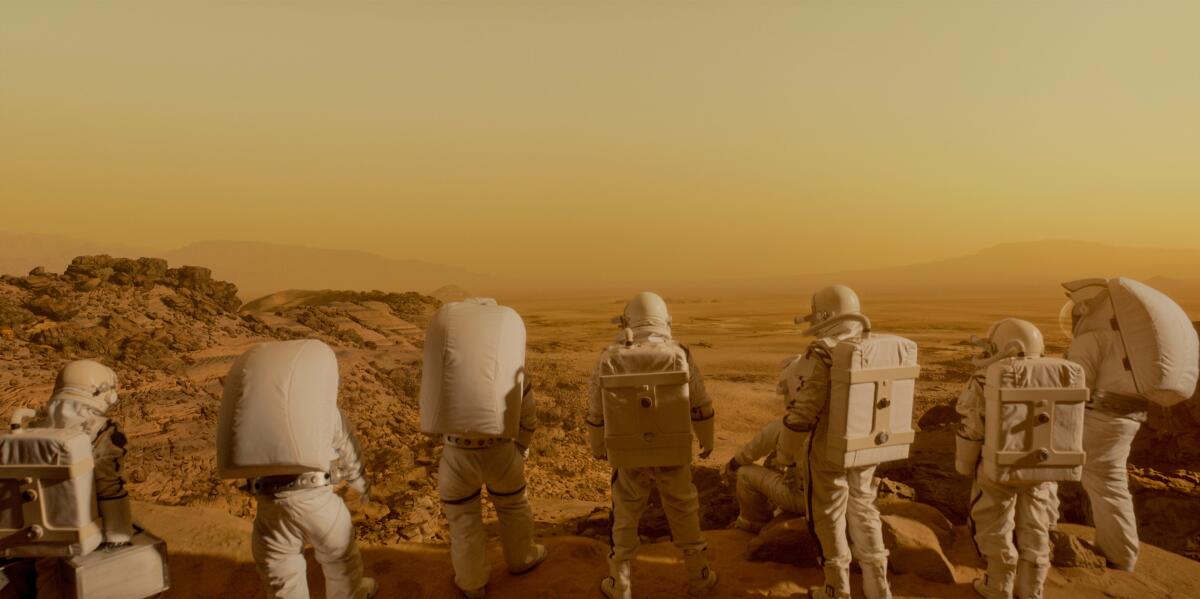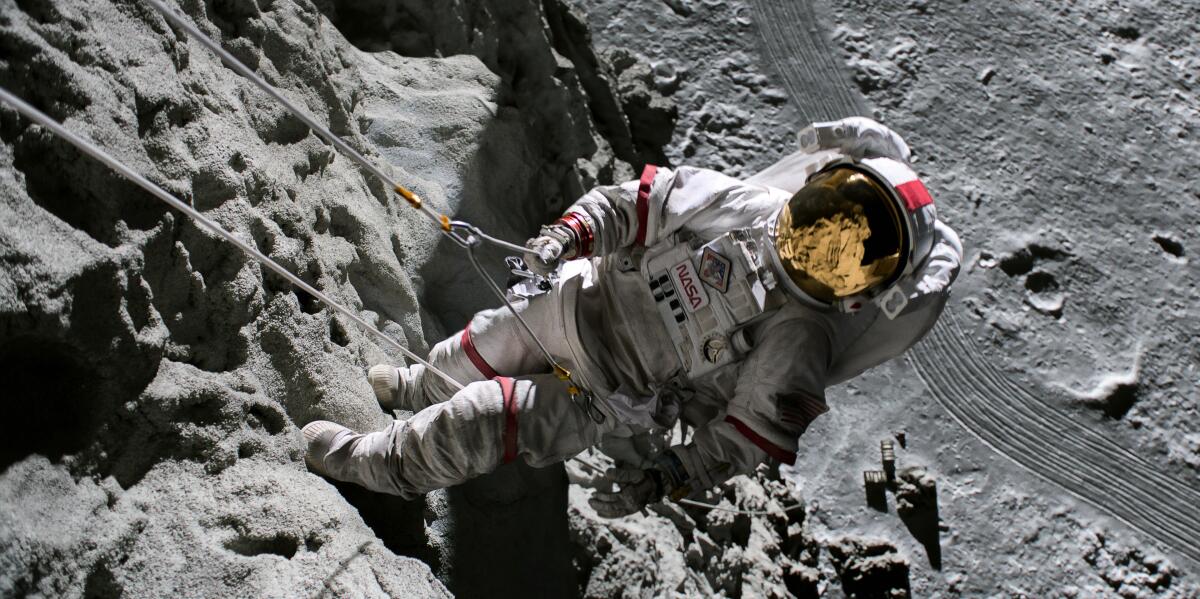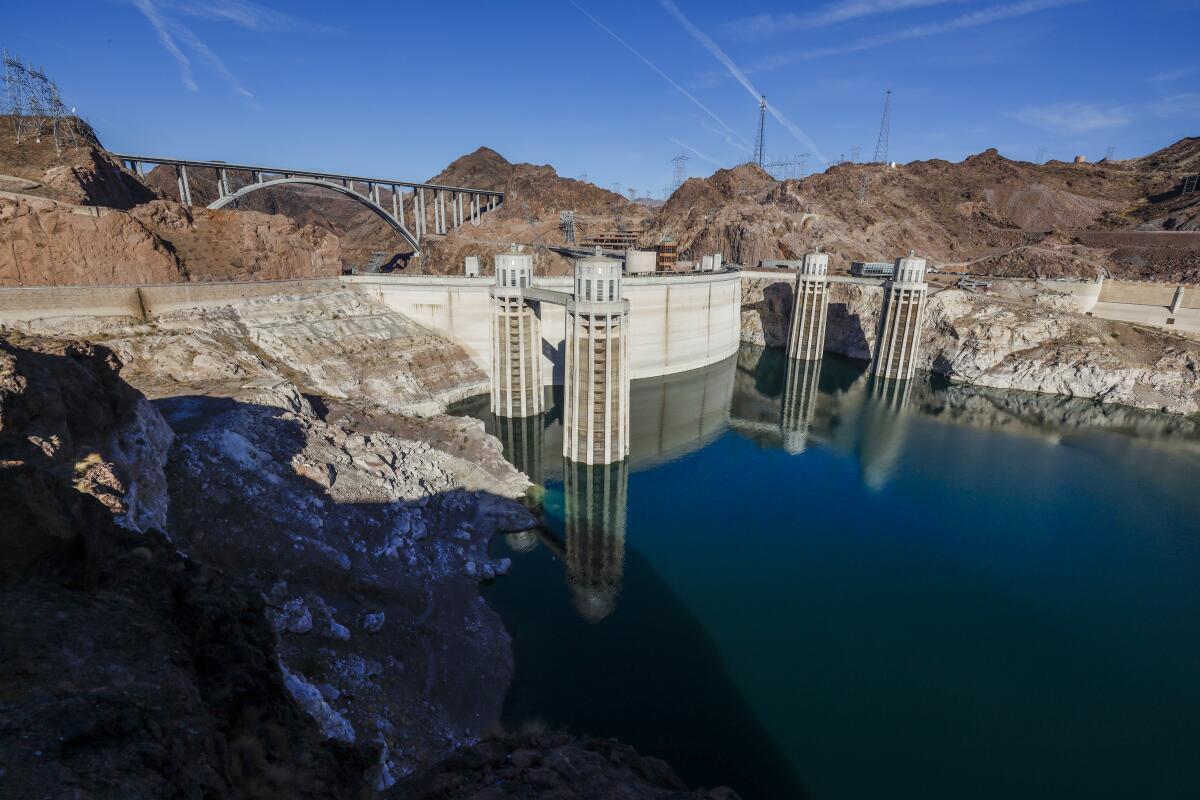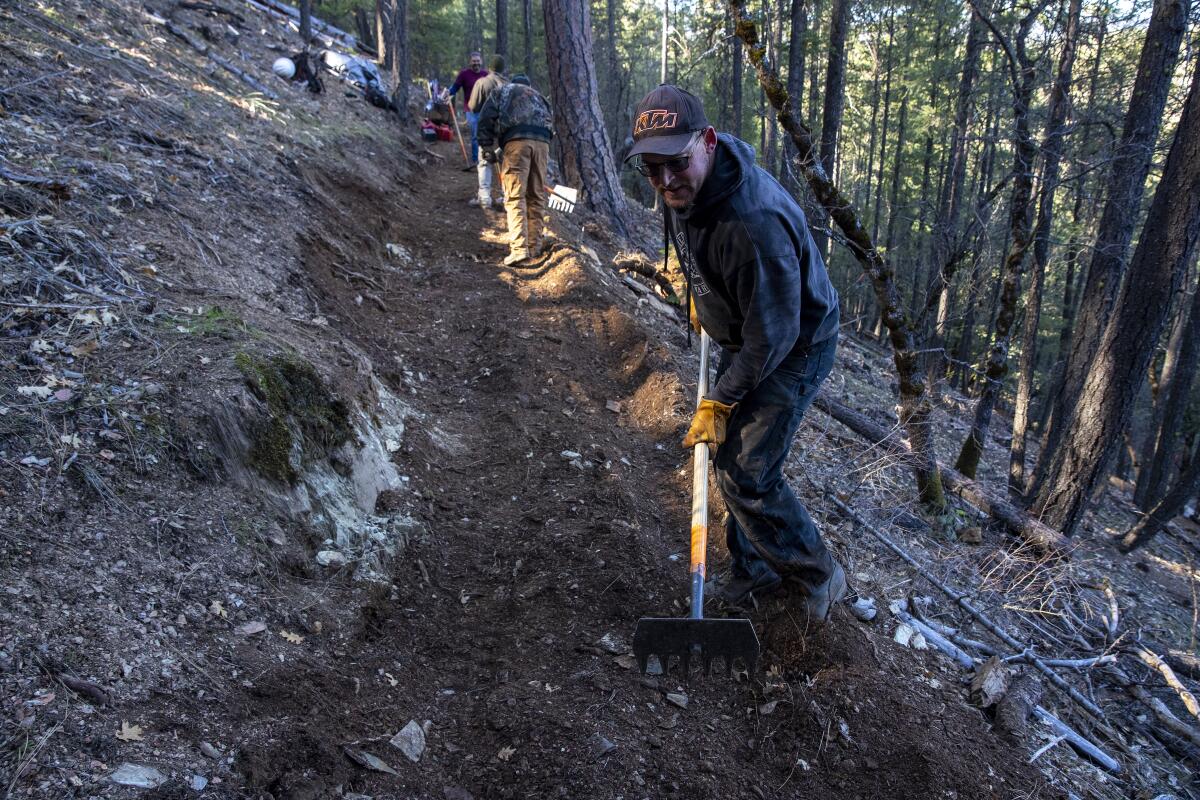Why ‘For All Mankind’ creator Ron Moore dreamed up a clean, nuclear future

- Share via
This is the Aug. 18, 2022, edition of Boiling Point, a weekly newsletter about climate change and the environment in California and the American West. Sign up here to get it in your inbox.
“A major breakthrough in nuclear fusion ...”
“A contract to mine massive deposits of Helium-3 on the moon ... an ideal resource for nuclear fusion ...”
“Scientist James Hansen testified that global warming has slowed due to the widespread shift from fossil fuels ...”
Those are brief snippets of 1980s newscasts from Season 3 of “For All Mankind,” the Apple TV+ show that imagines an alternate history where the Soviet Union reaches the moon before the United States. It’s an amazing show — one of my favorites recently — and its most recent season, which wrapped up last week, includes a fascinating narrative dealing with energy, climate change and the politics of fossil fuel job losses.
Not being able to help myself, I got in touch with Ron Moore, creator of “For All Mankind” and other TV shows including “Battlestar Galactica” and “Outlander.” I wanted to know why he made nuclear power a key plot point — especially after last week’s real-life news that California Gov. Gavin Newsom is willing to lend Pacific Gas & Electric Co. $1.4 billion to keep the Diablo Canyon nuclear plant running.
I was also curious how Moore views the value of space exploration in an era of climate crisis — and how optimistic or pessimistic he feels about resolving that crisis, as someone who’s spent a lot of time envisioning dystopian and utopian futures.
Spoilers ahead, although I’ll try to keep them relatively minor, for those of you who haven’t yet had the pleasure of watching “For All Mankind.” My conversation with Moore has been edited and condensed for clarity.

ME: Give me the background on this storyline where nuclear fusion technology has been developed successfully, and NASA has invested heavily in solar power and batteries — and as a result, electric cars are getting traction in the 1980s, and fossil fuels are starting to die out in the 1990s. Why did you make this part of “For All Mankind”?
MOORE: It’s kind of the DNA of the show — what are the consequences of an expanded U.S. space program? What if we had done all these more ambitious projects that NASA had on the drawing boards back in the ’60s and ’70s? Then we started talking about the real-world impacts of a greater infusion of funding into basic science research. A lot of research into solar power in particular came out of the space program.
If there had been a big investment in science and technology, maybe we would have gotten off fossil fuels faster. If there had been a big impulse to invest and do research, maybe we would have gotten to nuclear fusion. There would be more electric cars, and bigger investments in solar, and there would be a positive impact on climate change.
ME: Do you worry about promoting the idea that only a technological breakthrough, such as nuclear fusion, could solve climate change? Scientists have been working on fusion for a century, with limited success so far. Meanwhile we’ve already got technologies, including solar and wind power, that can get us most of the way to eliminating fossil fuels.
MOORE: That’s a fair point of view, although I’m not sure that’s everything the show is saying. I don’t think it’s saying there’s a magic wand to wave to get rid of our problems. We are trying to ask, what is a demonstrable way to show that things can be different, if society valued certain things more than we do now? If we really cared about certain investments — if we really cared about trying to make a difference — we could achieve great things. That’s the angle we’re coming from.
ME: Back in Season 2, you established that the Three Mile Island partial nuclear meltdown never happened, thanks to technological advancements from NASA. As a result, there’s much less public concern over nuclear power in the world of “For All Mankind.” That’s an interesting thought experiment, given the ongoing debate over the fate of California’s Diablo Canyon nuclear plant and similar facilities around the country.
Three Mile Island happened around the time the movie “The China Syndrome” came out. Those two incidents really changed public perception negatively toward nuclear power.
Absent that, we thought, maybe nuclear power never quite got the same bad stink on it. It would still face a lot of the same technical and political challenges about what you do with the waste material. But maybe if those things had not combined to turn the public so strongly against it, we would be in a different place with nuclear power.
ME: Season 3 also features a backlash from fossil fuel communities, which are seeing their jobs disappear as clean energy grows. It’s got similarities to what what’s happening in real life, only three decades earlier. Did you intend for that story to parallel the current economic and political realities?
MOORE: We felt like to give it a realistic portrayal of how this would work, there would be a backlash against clean energy just like there is now. We wanted to say that going down this path of renewables and solar and nuclear fusion is not cost-free. There will be an impact on people’s lives. There will be communities that are impacted very negatively, and there will be pushback, and there will be anger. There will be conspiracy theories. So we wanted to say, this is a better path, but it’s not a cost-free path.

ME: Another storyline that feels ripped from the headlines is the U.S. and Russia racing to mine lithium on the moon. And then you’ve got a scene where the NASA administrator back on Earth is bragging about his brand-new electric car, only it can’t go farther than 60 miles without recharging — and the charging station at NASA is super clunky.
MOORE: I went to my high school reunion, and I come from a small town in Central California. I drove from the Bay Area and took my electric car, and I was like, uh, am I going to be able to charge this thing when I get there?
There were actually chargers at a gas station in Chowchilla, Calif. I was amazed — couldn’t believe it. I plugged in my car, went to the Starbucks across the street, came back — and it just kept charging. It took an hour and a half. And I was like, really?
ME: Bigger picture, there’s controversy over the U.S. government and private investors spending money on space exploration at all, given the climate crisis and the need to fund solutions — like more and better electric car chargers. At the same time, you’ve got Elon Musk and Jeff Bezos pitching human space colonies as a kind of insurance policy against ecological collapse here on Earth. Which side of those debates do you fall on?
MOORE: I come from a place of idealism and romance. I’m a “Star Trek” fan in my bones, so a lot of this comes from that, and from my sense of the human spirit of adventure, of wanting to see what’s over the horizon. Inspiring young people around the world is a worthy endeavor. It’s hard to put a dollar value on dreams.
But for that idealism to be viable, there has to be a benefit. And I think NASA’s demonstrated there are benefits to the space program. We know about climate change in large part because of satellite technology. The space program does tell us a lot about Earth science. And the technological exploration of solar panels, of how to make electric cars — a lot of that benefited from the space program.
I’ve also always had trouble with the idea of, “We’re spending all this money on space. Why don’t we spend it back here on Earth?” Every dollar that is spent in the space program is spent on Earth. I think it’s a much better use of our tax dollars than buying another aircraft carrier. What we spend on the space program is a relatively small fraction of the federal budget, and it benefits humanity at large.
ME: Looking out at our future on Earth, with climate change getting worse — do you think we’ve got a shot at avoiding the worst outcomes, and even making life better?
MOORE: I’m basically an optimist. I’m always looking for the silver lining. I look toward, “How are we going to turn the corner?” As opposed to, “We’re never going to turn the corner.” I’m hoping we will eventually be forced into doing certain things we thought were impossible, like curbing emissions, and changing our habits, and the way our energy is used, and transportation. We don’t really have a choice other than to figure it out.
On that note, here’s what’s happening around the West:
TOP STORIES

California and six other states failed to strike a deal to use dramatically less Colorado River water — but rather than impose cutbacks, federal officials are giving them more time to negotiate. Here’s the story from my colleague Tony Briscoe, who notes that Arizona, Nevada and Mexico will see some Colorado River reductions under an existing agreement. If the seven states don’t figure things out soon, they could find themselves stuck in a drawn-out courtroom battle, The Times’ Ian James writes — an outcome nobody wants. In more positive news, the climate bill signed by President Biden this week includes $4 billion in drought relief for the Colorado River Basin, Ian and Jennifer Haberkorn write — money that could be used to pay farmers to take land out of production, potentially easing the way to a water-saving deal. Shorter term, outdoor watering will be banned for 4 million Southern Californians for 15 days next month as a leaky Colorado River pipeline is repaired, Hayley Smith reports.
July’s overnight low temperatures were the highest ever recorded in the U.S. — and August has been no picnic, either. California officials called their first Flex Alert of 2022 on Wednesday, asking people to use less electricity from 4 to 9 p.m. The heat is especially worrisome for warehouse workers at Amazon’s largest air freight facility on the West Coast, who walked off the job to protest what they say are unsafe conditions, my colleague Gregory Yee reports. Rising temperatures are also diminishing California’s water supplies, which is why Gov. Gavin Newsom released a long-term water plan that calls for investments in aquifer and reservoir storage, desalination, recycling and stormwater capture. More details here from Ian James. And even as the state gets drier overall, new research finds that global warming has doubled the risk of another Great Flood of 1862 — only this time, it could be a $1-trillion disaster larger than any in world history, with 10 million people displaced, The Times’ Louis Sahagún writes.
Newsom also proposed keeping the Diablo Canyon nuclear power plant open through 2035, and lending Pacific Gas & Electric $1.4 billion to help make it happen. I wrote about the governor’s controversial plan, which could keep the nuclear plant on the state’s Central Coast open an additional decade and would need to be approved by state lawmakers in the next two weeks. Newsom’s proposal would exempt the Diablo Canyon extension from the California Environmental Quality Act. L.A. Times columnist Michael Hiltzik is no fan, writing, “This scheme is lunacy.” In other nuclear news, critics contend California is giving Boeing a pass on cleaning up the Santa Susana Field Lab, site of a partial nuclear meltdown just outside Los Angeles. Local officials approved a state-backed cleanup plan that nearby residents say is far too weak and would leave dangerous pollutants in creeks feeding the L.A. River, my colleague Tony Briscoe writes. Hiltzik thinks this deal also stinks.
POLITICAL CLIMATE

President Biden signed the Inflation Reduction Act, marking the first time the U.S. has enacted sweeping climate legislation. My colleague Eli Stokols wrote about the signing ceremony, while Hugo Martín explained the electric vehicle tax credits you might now qualify for. Jessica Roy and Jon Healey wrote more broadly about how the bill could reduce energy costs and otherwise save you money. (Their story includes this gem of a sentence: “It is challenging to precisely estimate how much your household might save by getting to continue living on this planet, but moving into a biodome or to Mars sounds costly.”) Now that the climate bill is law, will it help Democrats drive young people to the polls in November? Even before the bill passed, about a quarter of recent Democratic TV ads in U.S. House races mentioned energy or environmental issues, The Times’ Jasper Goodman reports.
The third time may be the charm for replumbing the Sacramento-San Joaquin River Delta — even if it’s still a Southern California water grab. So says The Times’ Sacramento columnist, George Skelton, who writes that, compared to efforts by past governors, Newsom’s plan for a single tunnel beneath the delta “is smaller and more respectful of the bucolic estuary’s small farms, waterfowl habitat, unique recreational boating and historic tiny communities.” Columnist Robin Abcarian, meanwhile, writes that Angelenos could reduce their dependence on imported water by capturing water that falls from the sky. She talks with TreePeople founder Andy Lipkis, who has become a rainwater capture evangelist.
Truly terrifying new research finds that even a “limited” nuclear war could kill one-third of the world’s population. Scientists say a conflict in which less than 3% of the world’s nuclear weapons are detonated could kill billions of people as the explosions spark massive firestorms that inject sun-blocking soot into the atmosphere — cooling the climate, causing food production to collapse and leading to famine and starvation around the globe, my colleague Alex Wigglesworth writes. “We do know what’s going to happen if these weapons stay around,” said Ira Helfand, immediate past president of International Physicians for the Prevention of Nuclear War. “Sooner or later our luck is going to run out.”
ON OUR PUBLIC LANDS

An Indigenous-led effort is underway to build 600 miles of trails connecting down-on-their-luck Sierra Nevada towns, to bring in hikers and mountain bikers — hopefully without driving up housing prices too much. I loved this story by my colleague Jessica Garrison, with photos by Brian van der Brug. If the “Lost Sierra Route” is completed as planned, outdoor tourists “would flood in, drawn by the opportunity to traverse from town to town a la the Swiss Alps. They would exult in the stark beauty of the landscape, spend oodles of money in local restaurants, bars and hotels, and then go home again,” Jessica writes. In another gorgeous story out of the Sierra, The Times’ Diana Marcum wrote about a woman whose response to devastating fires was to start a flower delivery service, saying, “We need beauty like never before.” Be sure to linger on Francine Orr’s lovely photos.
The federal government agreed to plug and abandon nearly a dozen oil wells in California’s Carrizo Plain National Monument following a lawsuit from environmental groups. Details here from Mackenzie Shuman at the San Luis Obispo Tribune, who writes that the agreement still leaves nearly two dozen other idle wells to be dealt with. A judge, meanwhile, reinstated former President Obama’s moratorium on coal-lease sales on federal land, saying the Trump administration failed to fully analyze climate impacts when it started auctioning off coal again, the Associated Press’ Matthew Brown reports.
A new study finds that restoring wolf and beaver populations on public lands in the West — and reducing cattle grazing — would improve carbon sequestration and help achieve the goal of protecting 30% of U.S. lands and waters by 2030. Bob Berwyn covered the study for Inside Climate News, writing that wolves and beavers “are keystone species that help shape the landscapes they live in, and bringing them back in a big way could help forests and streams struggling to adapt to rising temperatures and aridification.” Another new study focused on Death Valley National Park finds that non-native donkeys might be an important food source for mountain lions — raising questions about the park’s plan to eliminate all donkeys, Asher Elbein writes for the New York Times.
THE ENERGY TRANSITION
Air quality regulators are investigating dozens of methane leaks from oil and gas facilities around Los Angeles after activists identified the leaks through infrared video. One leak from a petroleum storage tank was near homes in Signal Hill, Aaron Cantu reports for Capital & Main. The oil produced by those facilities not only warms the planet and pollutes the air when it’s burned in our car and truck engines — it also powers vehicles that are extremely deadly all on their own. After five people were killed in an L.A. County car crash last week, Times editorial writer Kerry Cavanaugh pointed out that cars killed almost as many people as guns in 2020. And columnist Steve Lopez wrote that Angelenos “want to know why — even as we move toward electric vehicles to save the planet — the auto industry produces gas-guzzling behemoths that easily go twice the highest speed limits.”
Cambridge University faculty and staff are preparing to vote on a binding resolution to stop accepting research funding and sponsorships from oil and gas companies. It’s part of a growing movement to end fossil fuel influence in academia, Hiroko Tabuchi writes for the New York Times. This is very much a live debate in California, too. As I noted a few months ago, Stanford University’s new climate and sustainability school has said it will work with — and accept donations from — fossil fuel companies.
In Morro Bay, a scenic city along the California coast, a retired gas plant may be replaced by lithium-ion batteries — and many locals want the three towering smokestacks to stick around. Read the fascinating story by my colleague Hailey Branson-Potts, who writes that the smokestacks have become “a cherished symbol of the town’s working-class ethos,” even joining with an ancient rock rising out of the sea to give Morro Bay its nickname: Three Stacks and a Rock. If you ask me, the nostalgic attachment to three polluting smokestacks is a reminder that for all the benefits of phasing out fossil fuels, change is hard — and policymakers and activists need to take that into account as they rewrite many communities’ futures.
ONE MORE THING
If you enjoyed my writeup above on the energy intrigue of “For All Mankind,” you’d probably enjoy the Science of Fiction, an excellent newsletter by journalist Maddie Stone. She’s written recently about how “Star Trek” changed NASA, among other topics, and she wrote last year about where in the galaxy we might find lithium, inspired by a storyline on “For All Mankind.”
For even more avant-garde climate content, check out 404, a new team of L.A. Times journalists that describes itself on Instagram as “the [un]official burner account of @latimes.” The 404’s recent Instagram posts include a puppet newscaster describing the new climate bill, a microplastics meme and a puppet newscaster explaining what’s going wrong on the Colorado River.
There’s a lot of good stuff out there, folks.
We’ll be back in your inbox next week. If you enjoyed this newsletter, please consider forwarding it to your friends and colleagues. For more climate and environment news, follow me on Twitter @Sammy_Roth.
Toward a more sustainable California
Get Boiling Point, our newsletter exploring climate change, energy and the environment, and become part of the conversation — and the solution.
You may occasionally receive promotional content from the Los Angeles Times.




